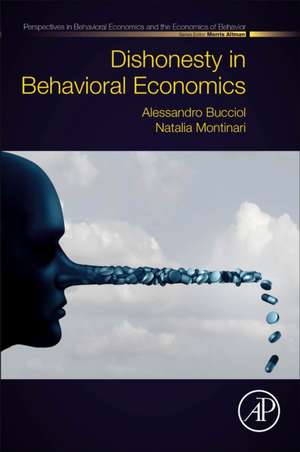Dishonesty in Behavioral Economics: Perspectives in Behavioral Economics and the Economics of Behavior
Editat de Alessandro Bucciol, Natalia Montinarien Limba Engleză Paperback – 6 iun 2019
- Reviews many key issues in the literature around lying, cheating, fraudulence, and deception
- Covers both state-of-the-art methods and data collection mechanisms (e.g., laboratory experiments, field experiments, online surveys)
- Discusses novel interdisciplinary research findings and from them proposes new avenues of research
Preț: 687.73 lei
Preț vechi: 939.66 lei
-27% Nou
Puncte Express: 1032
Preț estimativ în valută:
131.62€ • 136.36$ • 109.84£
131.62€ • 136.36$ • 109.84£
Carte tipărită la comandă
Livrare economică 15-29 martie
Preluare comenzi: 021 569.72.76
Specificații
ISBN-13: 9780128158579
ISBN-10: 0128158573
Pagini: 360
Dimensiuni: 152 x 229 x 21 mm
Greutate: 0.49 kg
Editura: ELSEVIER SCIENCE
Seria Perspectives in Behavioral Economics and the Economics of Behavior
ISBN-10: 0128158573
Pagini: 360
Dimensiuni: 152 x 229 x 21 mm
Greutate: 0.49 kg
Editura: ELSEVIER SCIENCE
Seria Perspectives in Behavioral Economics and the Economics of Behavior
Public țintă
Graduate and Post-graduate students in economics and across social science attending either a course on experimental methods, with a focus on dishonest behaviours, or a course in ethical behaviors. Policy-makers interested in designing interventions aimed at minimising dishonest behaviour in the society.Cuprins
Section 1: Dishonesty in behavioral economics: An overview
1. Dishonesty in behavioral economics: An overview
Section 2: Dishonesty among children and young adults
2.1 Dishonesty in young children
2.2 Dishonesty among children: Rural/urban status and parental migration
2.3 What does a young cheater look like? An innovative approach
2.4 Dishonesty among university students
2.5 Cheating in academic exams: A field study
Section 3: Dishonesty, individual, and social preferences
3.1 Do economists lie more?
3.2 Cheating and altruism by discipline
3.3 Negative externalities of cheating: An experiment with charities
3.4 Cheating: Perceptions and profit
3.5 An experiment on conformity in deception
Section 4: Dishonesty in daily life
4.1 Fare-dodging in the lab and the moral cost of dishonesty
4.2 The cost of being honest: Excessive change at the restaurant
4.3 Prosociality and fiscal honesty: Tax evasion in Italy, United Kingdom, and Sweden
4.4 Can upfront declarations of honesty improve anonymous self-reports of sensitive information?
1. Dishonesty in behavioral economics: An overview
Section 2: Dishonesty among children and young adults
2.1 Dishonesty in young children
2.2 Dishonesty among children: Rural/urban status and parental migration
2.3 What does a young cheater look like? An innovative approach
2.4 Dishonesty among university students
2.5 Cheating in academic exams: A field study
Section 3: Dishonesty, individual, and social preferences
3.1 Do economists lie more?
3.2 Cheating and altruism by discipline
3.3 Negative externalities of cheating: An experiment with charities
3.4 Cheating: Perceptions and profit
3.5 An experiment on conformity in deception
Section 4: Dishonesty in daily life
4.1 Fare-dodging in the lab and the moral cost of dishonesty
4.2 The cost of being honest: Excessive change at the restaurant
4.3 Prosociality and fiscal honesty: Tax evasion in Italy, United Kingdom, and Sweden
4.4 Can upfront declarations of honesty improve anonymous self-reports of sensitive information?








